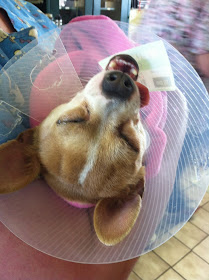Buster came to visit yesterday because his mom woke up and saw that overnight he had developed a "cherry eye." Being the devoted mom that she is she immediately drove him to the clinic for an evaluation.
Buster is a 1-1/2 year old chihuahua. He is active, happy, and has an underbite that can deliver a smile to make anyone laugh. He is the perfect candidate for cherry eye. He is the right breed, the right age, and the right size. Lucky for his mom! Cherry eye is diagnosed based on a physical examination. He was started on an anti-inflammatory to help relieve the swelling and scheduled for surgery with me today.
"Cherry eye" is the slang term given to the condition of the prolapse of the third eyelid. An ophthalmologist would call it "a prolapse of the nictating membrane." It occurs most commonly in young toy or brachycephalic breeds. When the gland prolapses a pink fleshy round mass will protrude out of the inside corner of the eye.
Cherry eye is the most common problem associated with the third eyelid. It is also one of the most common problems seen associated with the eye. It is most often seen affecting one eye, but in most cases it will affect both eyes.
It can occur without any sign of trauma, infection or disease. It can prolapse and then fall back into place and prolapse again. In general, once it prolapses it is very unlikely to return and stay back in its place. The gland prolapses because the tissue that anchors the gland.
A prolapsed gland can affect the eye by not producing enough tears, by irritating the cornea, and by causing excessive discharge from the eye.
The treatment for a prolapse is to surgically replace the gland into it's correct position. Because the gland plays a vitally important role in tear production it should not be removed. Dogs with a prolapsed third eyelid gland are at an increased risk of developing dry eye, also called KCS. This is yet another reason to not excise the gland.
The most popular way to replace the gland is with a pocket technique. The surgery should be performed by a veterinarian, or veterinary ophthalmologist who is comfortable with this surgery.
Even in the most skilled hands a replaced gland can re-prolapse. If the gland re-prolapses it should be replaced surgically as soon as possible.
 |
| Surgery to replace the prolapsed gland. |
 |
| Waking up from surgery. |
His surgery went very well. He woke up quickly and headed home with his mom.
I will check him in a few days, and we will keep our fingers crossed that the other side doesn't pop out over night.
 |
| At home tonight. |




No comments:
Post a Comment